Shilei Wen
Discriminator-Free Direct Preference Optimization for Video Diffusion
Apr 11, 2025Abstract:Direct Preference Optimization (DPO), which aligns models with human preferences through win/lose data pairs, has achieved remarkable success in language and image generation. However, applying DPO to video diffusion models faces critical challenges: (1) Data inefficiency. Generating thousands of videos per DPO iteration incurs prohibitive costs; (2) Evaluation uncertainty. Human annotations suffer from subjective bias, and automated discriminators fail to detect subtle temporal artifacts like flickering or motion incoherence. To address these, we propose a discriminator-free video DPO framework that: (1) Uses original real videos as win cases and their edited versions (e.g., reversed, shuffled, or noise-corrupted clips) as lose cases; (2) Trains video diffusion models to distinguish and avoid artifacts introduced by editing. This approach eliminates the need for costly synthetic video comparisons, provides unambiguous quality signals, and enables unlimited training data expansion through simple editing operations. We theoretically prove the framework's effectiveness even when real videos and model-generated videos follow different distributions. Experiments on CogVideoX demonstrate the efficiency of the proposed method.
AffineQuant: Affine Transformation Quantization for Large Language Models
Mar 19, 2024Abstract:The significant resource requirements associated with Large-scale Language Models (LLMs) have generated considerable interest in the development of techniques aimed at compressing and accelerating neural networks. Among these techniques, Post-Training Quantization (PTQ) has emerged as a subject of considerable interest due to its noteworthy compression efficiency and cost-effectiveness in the context of training. Existing PTQ methods for LLMs limit the optimization scope to scaling transformations between pre- and post-quantization weights. In this paper, we advocate for the direct optimization using equivalent Affine transformations in PTQ (AffineQuant). This approach extends the optimization scope and thus significantly minimizing quantization errors. Additionally, by employing the corresponding inverse matrix, we can ensure equivalence between the pre- and post-quantization outputs of PTQ, thereby maintaining its efficiency and generalization capabilities. To ensure the invertibility of the transformation during optimization, we further introduce a gradual mask optimization method. This method initially focuses on optimizing the diagonal elements and gradually extends to the other elements. Such an approach aligns with the Levy-Desplanques theorem, theoretically ensuring invertibility of the transformation. As a result, significant performance improvements are evident across different LLMs on diverse datasets. To illustrate, we attain a C4 perplexity of 15.76 (2.26 lower vs 18.02 in OmniQuant) on the LLaMA2-7B model of W4A4 quantization without overhead. On zero-shot tasks, AffineQuant achieves an average of 58.61 accuracy (1.98 lower vs 56.63 in OmniQuant) when using 4/4-bit quantization for LLaMA-30B, which setting a new state-of-the-art benchmark for PTQ in LLMs.
DiffusionGPT: LLM-Driven Text-to-Image Generation System
Jan 18, 2024Abstract:Diffusion models have opened up new avenues for the field of image generation, resulting in the proliferation of high-quality models shared on open-source platforms. However, a major challenge persists in current text-to-image systems are often unable to handle diverse inputs, or are limited to single model results. Current unified attempts often fall into two orthogonal aspects: i) parse Diverse Prompts in input stage; ii) activate expert model to output. To combine the best of both worlds, we propose DiffusionGPT, which leverages Large Language Models (LLM) to offer a unified generation system capable of seamlessly accommodating various types of prompts and integrating domain-expert models. DiffusionGPT constructs domain-specific Trees for various generative models based on prior knowledge. When provided with an input, the LLM parses the prompt and employs the Trees-of-Thought to guide the selection of an appropriate model, thereby relaxing input constraints and ensuring exceptional performance across diverse domains. Moreover, we introduce Advantage Databases, where the Tree-of-Thought is enriched with human feedback, aligning the model selection process with human preferences. Through extensive experiments and comparisons, we demonstrate the effectiveness of DiffusionGPT, showcasing its potential for pushing the boundaries of image synthesis in diverse domains.
MeMaHand: Exploiting Mesh-Mano Interaction for Single Image Two-Hand Reconstruction
Apr 17, 2023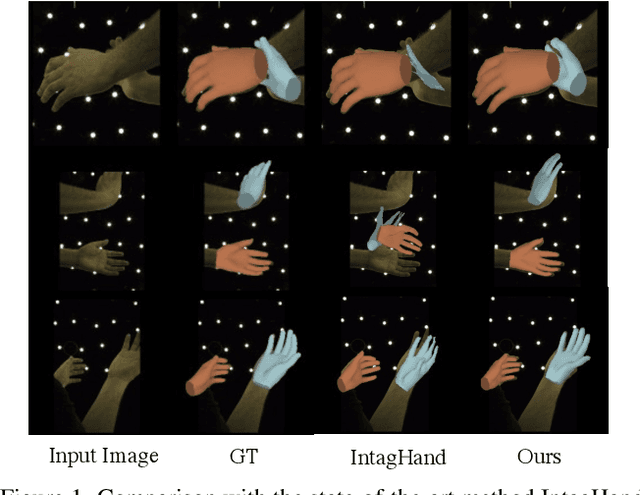

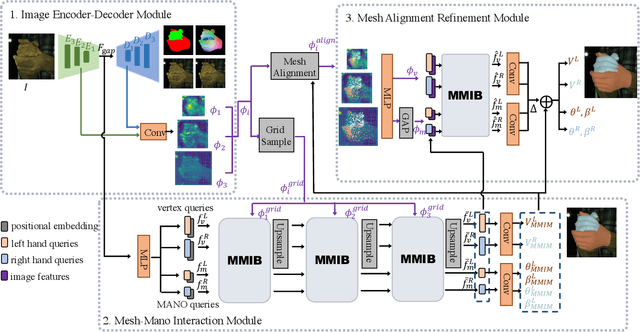

Abstract:Existing methods proposed for hand reconstruction tasks usually parameterize a generic 3D hand model or predict hand mesh positions directly. The parametric representations consisting of hand shapes and rotational poses are more stable, while the non-parametric methods can predict more accurate mesh positions. In this paper, we propose to reconstruct meshes and estimate MANO parameters of two hands from a single RGB image simultaneously to utilize the merits of two kinds of hand representations. To fulfill this target, we propose novel Mesh-Mano interaction blocks (MMIBs), which take mesh vertices positions and MANO parameters as two kinds of query tokens. MMIB consists of one graph residual block to aggregate local information and two transformer encoders to model long-range dependencies. The transformer encoders are equipped with different asymmetric attention masks to model the intra-hand and inter-hand attention, respectively. Moreover, we introduce the mesh alignment refinement module to further enhance the mesh-image alignment. Extensive experiments on the InterHand2.6M benchmark demonstrate promising results over the state-of-the-art hand reconstruction methods.
Solving Oscillation Problem in Post-Training Quantization Through a Theoretical Perspective
Apr 04, 2023Abstract:Post-training quantization (PTQ) is widely regarded as one of the most efficient compression methods practically, benefitting from its data privacy and low computation costs. We argue that an overlooked problem of oscillation is in the PTQ methods. In this paper, we take the initiative to explore and present a theoretical proof to explain why such a problem is essential in PTQ. And then, we try to solve this problem by introducing a principled and generalized framework theoretically. In particular, we first formulate the oscillation in PTQ and prove the problem is caused by the difference in module capacity. To this end, we define the module capacity (ModCap) under data-dependent and data-free scenarios, where the differentials between adjacent modules are used to measure the degree of oscillation. The problem is then solved by selecting top-k differentials, in which the corresponding modules are jointly optimized and quantized. Extensive experiments demonstrate that our method successfully reduces the performance drop and is generalized to different neural networks and PTQ methods. For example, with 2/4 bit ResNet-50 quantization, our method surpasses the previous state-of-the-art method by 1.9%. It becomes more significant on small model quantization, e.g. surpasses BRECQ method by 6.61% on MobileNetV2*0.5.
FreeSeg: Unified, Universal and Open-Vocabulary Image Segmentation
Mar 30, 2023
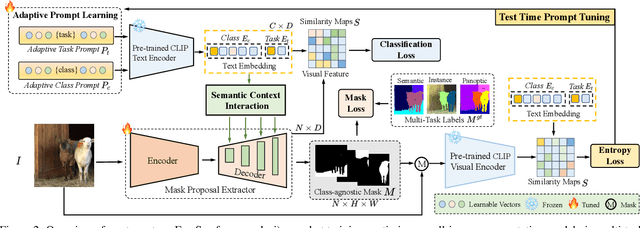
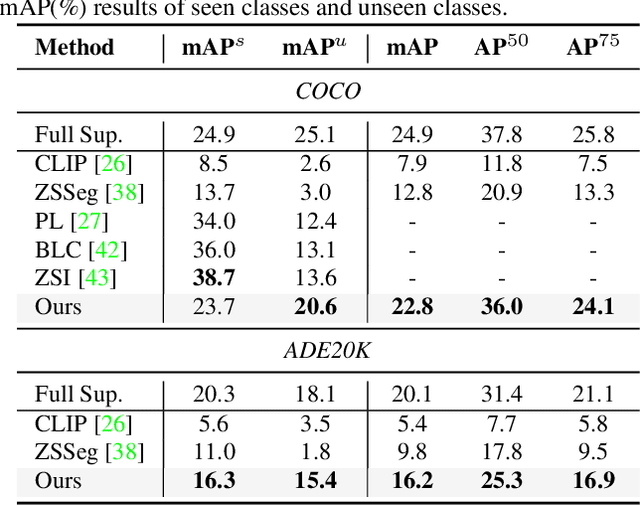
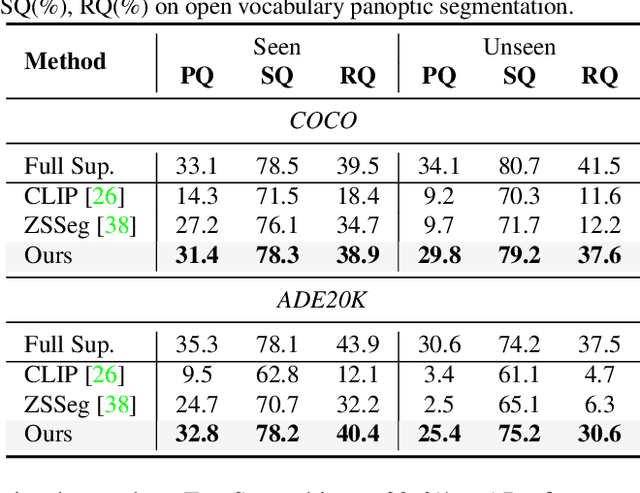
Abstract:Recently, open-vocabulary learning has emerged to accomplish segmentation for arbitrary categories of text-based descriptions, which popularizes the segmentation system to more general-purpose application scenarios. However, existing methods devote to designing specialized architectures or parameters for specific segmentation tasks. These customized design paradigms lead to fragmentation between various segmentation tasks, thus hindering the uniformity of segmentation models. Hence in this paper, we propose FreeSeg, a generic framework to accomplish Unified, Universal and Open-Vocabulary Image Segmentation. FreeSeg optimizes an all-in-one network via one-shot training and employs the same architecture and parameters to handle diverse segmentation tasks seamlessly in the inference procedure. Additionally, adaptive prompt learning facilitates the unified model to capture task-aware and category-sensitive concepts, improving model robustness in multi-task and varied scenarios. Extensive experimental results demonstrate that FreeSeg establishes new state-of-the-art results in performance and generalization on three segmentation tasks, which outperforms the best task-specific architectures by a large margin: 5.5% mIoU on semantic segmentation, 17.6% mAP on instance segmentation, 20.1% PQ on panoptic segmentation for the unseen class on COCO.
Beyond Self-Supervision: A Simple Yet Effective Network Distillation Alternative to Improve Backbones
Mar 10, 2021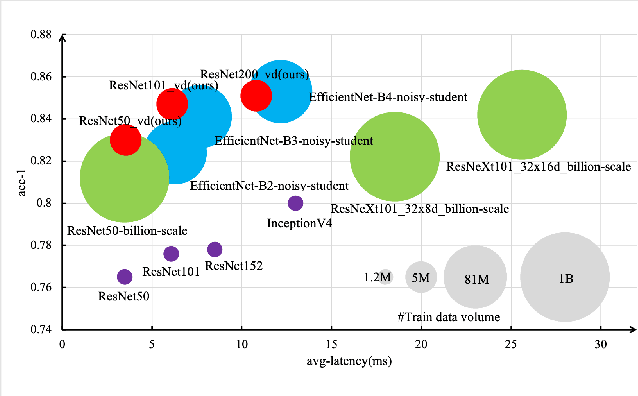
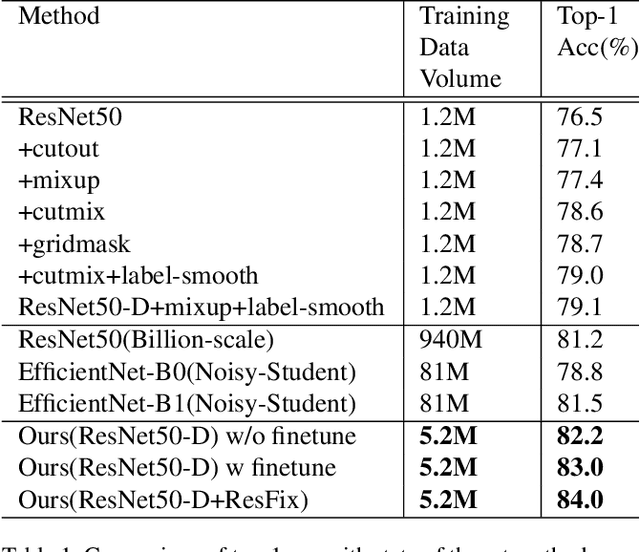
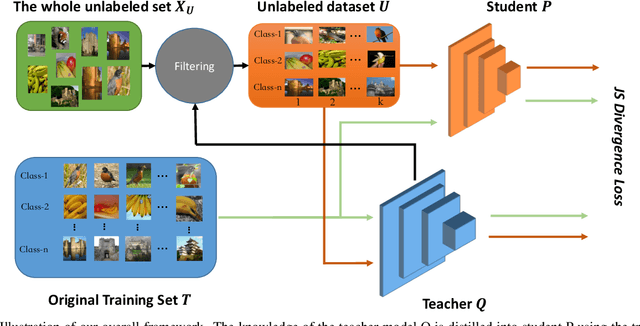
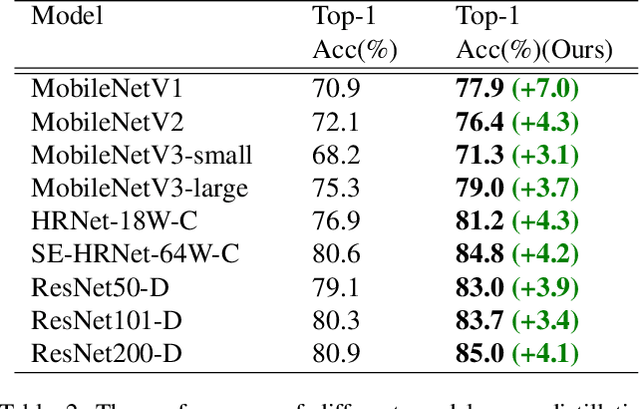
Abstract:Recently, research efforts have been concentrated on revealing how pre-trained model makes a difference in neural network performance. Self-supervision and semi-supervised learning technologies have been extensively explored by the community and are proven to be of great potential in obtaining a powerful pre-trained model. However, these models require huge training costs (i.e., hundreds of millions of images or training iterations). In this paper, we propose to improve existing baseline networks via knowledge distillation from off-the-shelf pre-trained big powerful models. Different from existing knowledge distillation frameworks which require student model to be consistent with both soft-label generated by teacher model and hard-label annotated by humans, our solution performs distillation by only driving prediction of the student model consistent with that of the teacher model. Therefore, our distillation setting can get rid of manually labeled data and can be trained with extra unlabeled data to fully exploit capability of teacher model for better learning. We empirically find that such simple distillation settings perform extremely effective, for example, the top-1 accuracy on ImageNet-1k validation set of MobileNetV3-large and ResNet50-D can be significantly improved from 75.2% to 79% and 79.1% to 83%, respectively. We have also thoroughly analyzed what are dominant factors that affect the distillation performance and how they make a difference. Extensive downstream computer vision tasks, including transfer learning, object detection and semantic segmentation, can significantly benefit from the distilled pretrained models. All our experiments are implemented based on PaddlePaddle, codes and a series of improved pretrained models with ssld suffix are available in PaddleClas.
Coherent Loss: A Generic Framework for Stable Video Segmentation
Oct 25, 2020

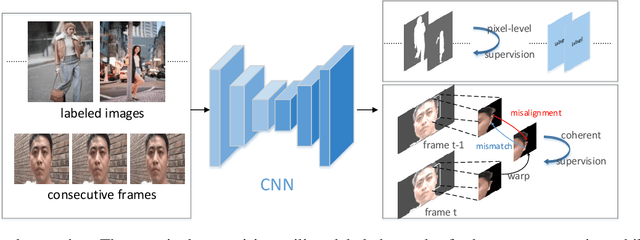

Abstract:Video segmentation approaches are of great importance for numerous vision tasks especially in video manipulation for entertainment. Due to the challenges associated with acquiring high-quality per-frame segmentation annotations and large video datasets with different environments at scale, learning approaches shows overall higher accuracy on test dataset but lack strict temporal constraints to self-correct jittering artifacts in most practical applications. We investigate how this jittering artifact degrades the visual quality of video segmentation results and proposed a metric of temporal stability to numerically evaluate it. In particular, we propose a Coherent Loss with a generic framework to enhance the performance of a neural network against jittering artifacts, which combines with high accuracy and high consistency. Equipped with our method, existing video object/semantic segmentation approaches achieve a significant improvement in term of more satisfactory visual quality on video human dataset, which we provide for further research in this field, and also on DAVIS and Cityscape.
Discriminative Sounding Objects Localization via Self-supervised Audiovisual Matching
Oct 12, 2020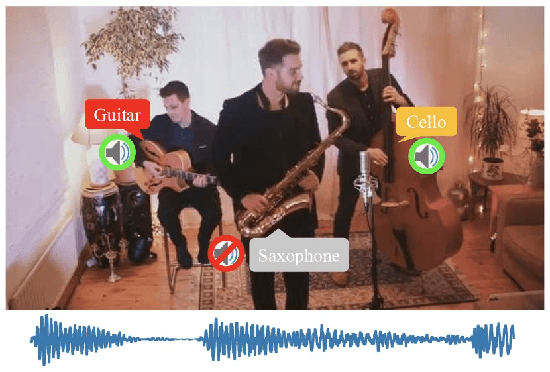

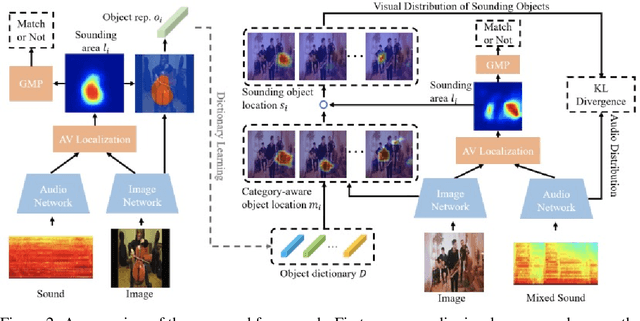

Abstract:Discriminatively localizing sounding objects in cocktail-party, i.e., mixed sound scenes, is commonplace for humans, but still challenging for machines. In this paper, we propose a two-stage learning framework to perform self-supervised class-aware sounding object localization. First, we propose to learn robust object representations by aggregating the candidate sound localization results in the single source scenes. Then, class-aware object localization maps are generated in the cocktail-party scenarios by referring the pre-learned object knowledge, and the sounding objects are accordingly selected by matching audio and visual object category distributions, where the audiovisual consistency is viewed as the self-supervised signal. Experimental results in both realistic and synthesized cocktail-party videos demonstrate that our model is superior in filtering out silent objects and pointing out the location of sounding objects of different classes. Code is available at https://github.com/DTaoo/Discriminative-Sounding-Objects-Localization.
PP-YOLO: An Effective and Efficient Implementation of Object Detector
Aug 03, 2020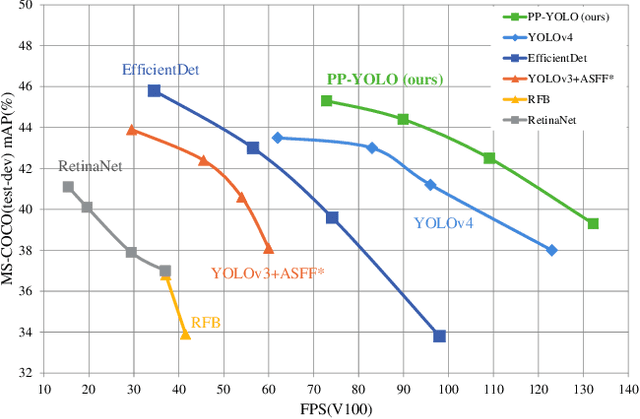
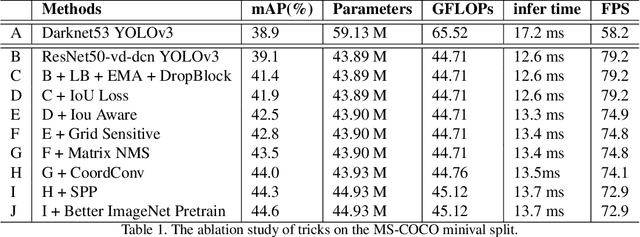
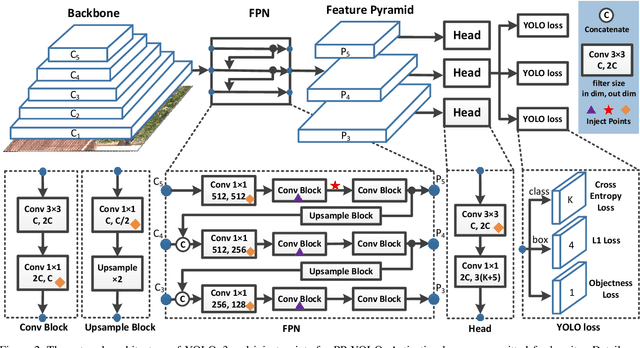
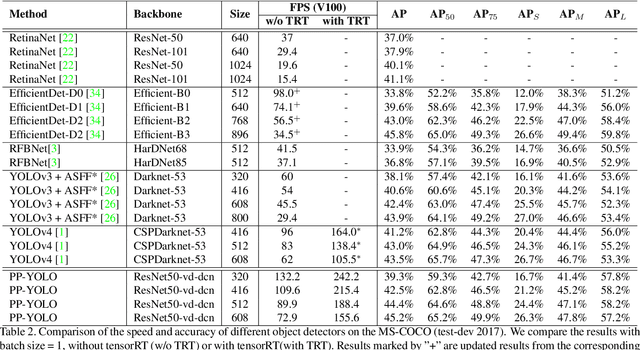
Abstract:Object detection is one of the most important areas in computer vision, which plays a key role in various practical scenarios. Due to limitation of hardware, it is often necessary to sacrifice accuracy to ensure the infer speed of the detector in practice. Therefore, the balance between effectiveness and efficiency of object detector must be considered. The goal of this paper is to implement an object detector with relatively balanced effectiveness and efficiency that can be directly applied in actual application scenarios, rather than propose a novel detection model. Considering that YOLOv3 has been widely used in practice, we develop a new object detector based on YOLOv3. We mainly try to combine various existing tricks that almost not increase the number of model parameters and FLOPs, to achieve the goal of improving the accuracy of detector as much as possible while ensuring that the speed is almost unchanged. Since all experiments in this paper are conducted based on PaddlePaddle, we call it PP-YOLO. By combining multiple tricks, PP-YOLO can achieve a better balance between effectiveness (45.2% mAP) and efficiency (72.9 FPS), surpassing the existing state-of-the-art detectors such as EfficientDet and YOLOv4.Source code is at https://github.com/PaddlePaddle/PaddleDetection.
 Add to Chrome
Add to Chrome Add to Firefox
Add to Firefox Add to Edge
Add to Edge